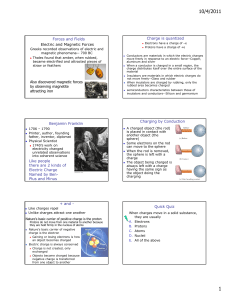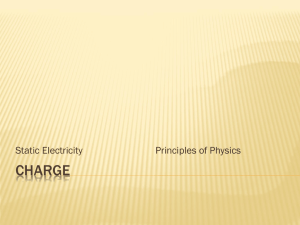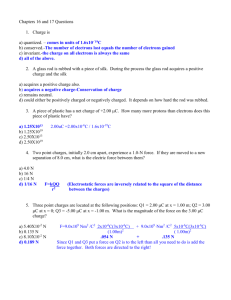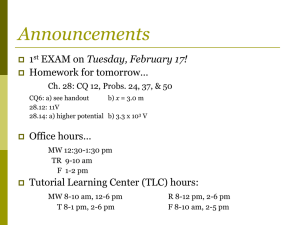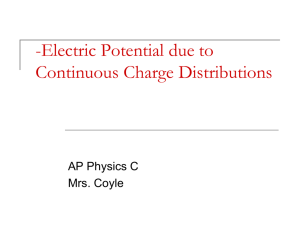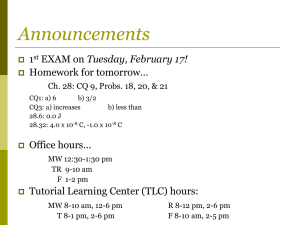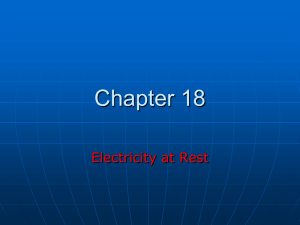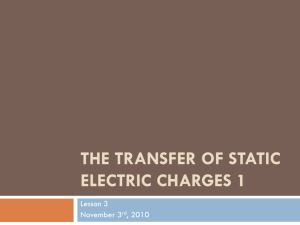Electrostatics Review For 1-17 below, use the word bank at the
advertisement
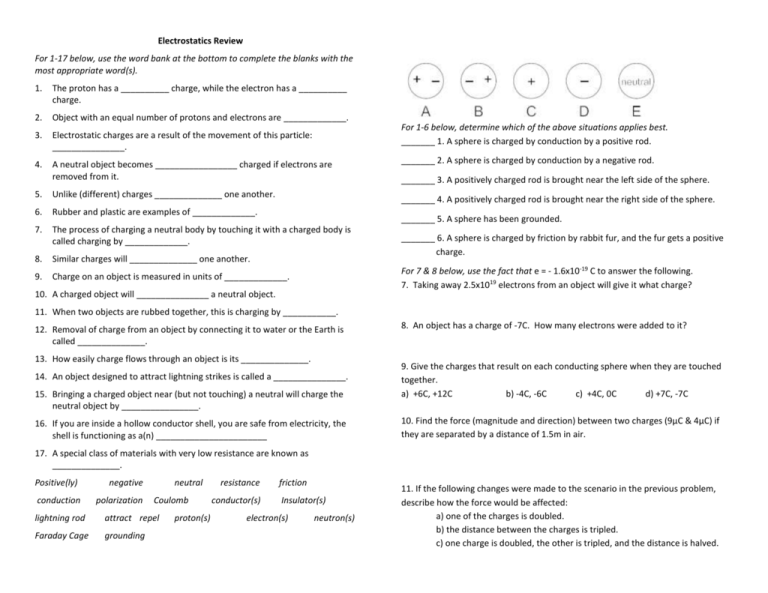
Electrostatics Review For 1-17 below, use the word bank at the bottom to complete the blanks with the most appropriate word(s). 1. The proton has a __________ charge, while the electron has a __________ charge. 2. Object with an equal number of protons and electrons are _____________. 3. Electrostatic charges are a result of the movement of this particle: _______________. 4. A neutral object becomes _________________ charged if electrons are removed from it. 5. Unlike (different) charges ______________ one another. 6. Rubber and plastic are examples of _____________. 7. The process of charging a neutral body by touching it with a charged body is called charging by _____________. 8. Similar charges will ______________ one another. 9. Charge on an object is measured in units of _____________. For 1-6 below, determine which of the above situations applies best. _______ 1. A sphere is charged by conduction by a positive rod. _______ 2. A sphere is charged by conduction by a negative rod. _______ 3. A positively charged rod is brought near the left side of the sphere. _______ 4. A positively charged rod is brought near the right side of the sphere. _______ 5. A sphere has been grounded. _______ 6. A sphere is charged by friction by rabbit fur, and the fur gets a positive charge. For 7 & 8 below, use the fact that e = - 1.6x10-19 C to answer the following. 7. Taking away 2.5x1019 electrons from an object will give it what charge? 10. A charged object will _______________ a neutral object. 11. When two objects are rubbed together, this is charging by ___________. 12. Removal of charge from an object by connecting it to water or the Earth is called ______________. 13. How easily charge flows through an object is its ______________. 14. An object designed to attract lightning strikes is called a _______________. 15. Bringing a charged object near (but not touching) a neutral will charge the neutral object by ________________. 16. If you are inside a hollow conductor shell, you are safe from electricity, the shell is functioning as a(n) _______________________ 8. An object has a charge of -7C. How many electrons were added to it? 9. Give the charges that result on each conducting sphere when they are touched together. a) +6C, +12C b) -4C, -6C c) +4C, 0C d) +7C, -7C 10. Find the force (magnitude and direction) between two charges (9µC & 4µC) if they are separated by a distance of 1.5m in air. 17. A special class of materials with very low resistance are known as ______________. Positive(ly) conduction negative polarization neutral Coulomb lightning rod attract repel Faraday Cage grounding proton(s) resistance conductor(s) friction Insulator(s) electron(s) neutron(s) 11. If the following changes were made to the scenario in the previous problem, describe how the force would be affected: a) one of the charges is doubled. b) the distance between the charges is tripled. c) one charge is doubled, the other is tripled, and the distance is halved.
